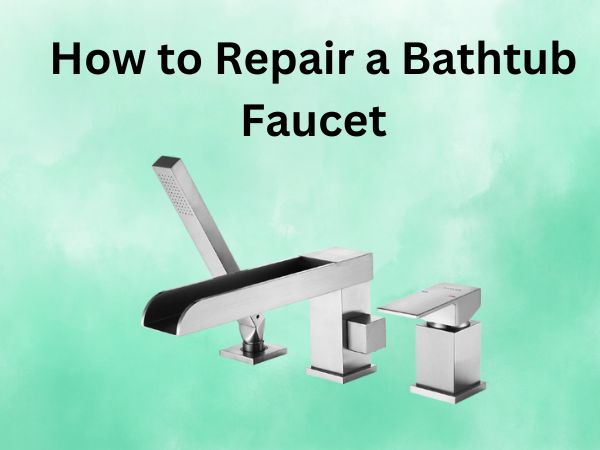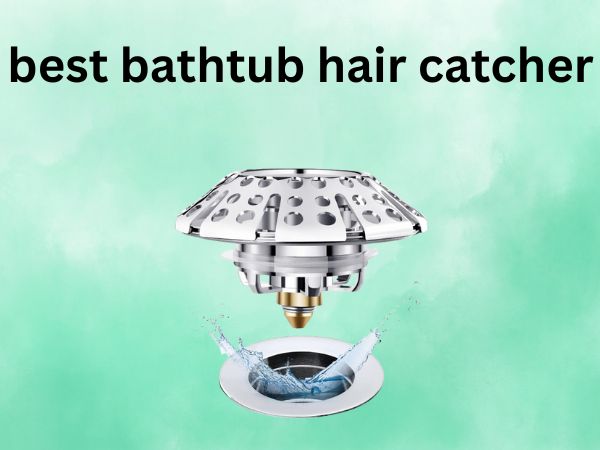How to Repair a Bathtub Faucet [A Complete DIY Guide]
Do you have a leaky bathtub faucet driving you crazy with that constant drip-drip-drip? Or perhaps your tub spout isn’t flowing like it used to? Don’t worry – you’re not alone, and you don’t necessarily need to call a plumber. With some basic tools and a little know-how, you can fix many common bathtub faucet problems yourself. In this comprehensive guide, I’ll walk you through everything you need to know about repairing your bathtub faucet and save you both time and money in the process.
Table of Contents
Understanding Your Bathtub Faucet
Before diving into repairs, it’s crucial to understand what you’re working with. Bathtub faucets might seem simple, but they come in various types, each with their own repair methods.
Common Types of Bathtub Faucets
There are four main types of bathtub faucets you might encounter in your home:
- Compression Faucets: These are the oldest and most common type, featuring separate hot and cold handles that compress a rubber washer against a valve seat to control water flow.
- Cartridge Faucets: These contain a movable cartridge that controls water flow and temperature. They can have either one or two handles.
- Ball-Type Faucets: Less common in bathtubs but featuring a ball-shaped mechanism that controls water flow and temperature. These typically have a single handle.
- Ceramic Disk Faucets: These modern faucets use ceramic disks that rotate against each other to control water flow, offering durability and reliability.
Identifying your faucet type is the first step in proper repair. Look at the handles, the way they move, and if possible, check the manufacturer’s name which is often printed somewhere on the fixture.
Identifying Signs of Faucet Problems
How do you know when your bathtub faucet needs repair? Here are some telltale signs:
- Dripping when turned off: This is the most obvious sign and usually indicates worn washers or O-rings.
- Squeaking or difficult-to-turn handles: This suggests internal parts are worn or mineral deposits have built up.
- Water leaking around the base of the spout or handles: This indicates seal problems.
- Inconsistent water temperature: This could mean issues with the mixing valve.
- Reduced water pressure: This might be due to mineral buildup or a partially blocked cartridge.
Tools and Materials Needed for Bathtub Faucet Repair
Before starting any repair job, gathering the right tools and materials will make your task much easier.
Essential Tools for the Job
Here’s what you’ll typically need:
- Adjustable wrench
- Phillips and flathead screwdrivers
- Allen wrench set
- Penetrating oil (like WD-40)
- Needle-nose pliers
- Pipe wrench
- Utility knife
- Cloth or rag
- Flashlight
- Plumber’s tape (Teflon tape)
- Plumber’s grease
For stubborn fixtures, you might also want a faucet handle puller, which can be rented from most hardware stores.
Materials You Might Need to Replace
Depending on your faucet type and the specific issue, you might need replacement parts such as:
- Washers and O-rings
- Valve stems
- Cartridges
- Seats
- Springs
- Complete faucet trim kit (for extensive damage)
I recommend taking your old parts to the hardware store for exact matching, as sizes and designs vary greatly between manufacturers.
Preparing for Your Bathtub Faucet Repair
Proper preparation prevents poor performance! Taking the right steps before you start will save you headaches later.
Safety Precautions
Safety first, always:
- Place a towel or rubber mat in the tub to prevent tools from slipping and damaging the surface
- Cover the drain with a cloth to prevent small parts from falling in
- Consider wearing gloves to protect your hands from sharp edges
- Keep a bucket handy for excess water and to hold small parts
Shutting Off Water Supply
This critical step prevents water from spraying everywhere when you disassemble the faucet.
Locating Your Water Shut-Off Valve
Most homes have several shut-off options:
- Fixture-specific valves: Some bathtubs have dedicated shut-off valves underneath or behind access panels.
- Bathroom shut-off: Some homes have valves that control water to the entire bathroom.
- Main water shut-off: When all else fails, you can shut off water to the entire house. This is typically located where the main water line enters your home, often in the basement, crawl space, or near the water meter.
After shutting off the water, open the faucet to drain any remaining water in the lines.
Step-by-Step Guide to Fixing a Leaky Compression Faucet
Compression faucets are the most common type found in older homes, and fortunately, they’re relatively straightforward to repair.
Removing the Faucet Handle
- Look for a decorative cap on top of each handle, often with H (hot) or C (cold) markings
- Pry this cap off carefully with a flathead screwdriver
- Underneath, you’ll find a screw that secures the handle to the stem
- Remove this screw using a Phillips screwdriver
- Pull the handle straight up to remove it (if it’s stuck, apply penetrating oil and wait a few minutes)
Accessing and Replacing the Washer
- With the handle removed, you’ll see the stem assembly
- Use an adjustable wrench to unscrew the stem by turning it counterclockwise
- Remove the stem completely
- At the bottom of the stem, you’ll find a rubber washer held in place by a small screw
- Remove the screw and the old washer
- Clean the stem thoroughly, removing any mineral deposits or corrosion
- Install the new washer of the exact same size
- Secure it with the screw
If the valve seat (the part the washer presses against) appears damaged, you may need to replace or resurface it using a valve seat grinding tool.
Reassembling the Faucet
- Apply a small amount of plumber’s grease to the stem threads
- Reinsert the stem and tighten it using your wrench
- Place the handle back on the stem
- Secure the handle with the screw
- Snap the decorative cap back in place
- Repeat for the other handle if necessary
- Turn the water back on and test for leaks
Repairing a Cartridge Faucet
Cartridge faucets are common in more modern homes and require a slightly different approach.
Disassembling a Cartridge Faucet
- Remove the handle as described above (look for set screws on the side of the handle base if there’s no top screw)
- You’ll likely see a retaining clip holding the cartridge in place
- Remove this clip using needle-nose pliers
- Some models have a cartridge retaining nut that needs to be unscrewed
- Pull the cartridge straight up and out
Replacing the Cartridge
- Note the orientation of the old cartridge before removing it completely
- Take the old cartridge to your hardware store to find an exact replacement
- Clean the faucet body interior thoroughly
- Insert the new cartridge in the same orientation as the old one
- Replace the retaining clip or nut
- Reassemble the handle
Tips for Stuck Cartridges
Cartridges can become stuck due to mineral buildup or corrosion. If yours won’t budge:
- Apply penetrating oil and wait 10-15 minutes
- Use a pair of pliers with a cloth to protect the cartridge from damage
- Gently rock the cartridge back and forth while pulling upward
- For extremely stubborn cartridges, special cartridge pullers are available at hardware stores
How to Fix a Ball-Type Faucet
While less common in bathtubs, ball-type faucets may be present in some fixtures.
Ball Faucet Disassembly Process
- Remove the handle by loosening the set screw (usually requires an Allen wrench)
- Unscrew and remove the cap that holds the ball in place
- Remove the ball, noting its orientation
- Under the ball, you’ll find springs and rubber seats that control water flow
Common Ball Faucet Issues and Solutions
- Leaking: Usually caused by worn O-rings or seats and springs. Replace these components.
- Difficult movement: The ball may be corroded or has mineral buildup. Clean thoroughly or replace.
- Water temperature issues: The slots in the ball may be blocked. Clean or replace the ball.
Ball faucet repair kits are available that include all the necessary replacement parts.
Dealing with Ceramic Disk Faucets
Ceramic disk faucets are the most modern and durable type but still can develop problems.
Accessing the Ceramic Disk
- Remove the handle (usually with a set screw at the base)
- Unscrew the disk cylinder cap
- Lift out the ceramic disk assembly
Cleaning vs. Replacing the Disk
- For mineral deposits: Soak the disk assembly in white vinegar for several hours, then rinse thoroughly
- For scratches or cracks: The entire disk assembly needs replacement
- For O-ring issues: Replace the O-rings that seal the assembly
When reassembling, don’t overtighten the components, as ceramic can crack under too much pressure.
Troubleshooting Common Bathtub Faucet Problems
Sometimes standard repairs don’t resolve the issue. Here are solutions to other common problems.
Handling Persistent Leaks
If you’ve replaced washers or cartridges but still have leaks:
- Check the valve seat for pitting or damage
- Inspect the faucet body for cracks
- Make sure all connections are tight
- Verify that replacement parts are the correct size and type
- Consider whether the entire faucet assembly needs replacement
Fixing Low Water Pressure
Low pressure often indicates blockages:
- Remove the faucet aerator or showerhead and check for mineral buildup
- Clean or replace as needed
- Check for kinked supply lines
- Verify that shut-off valves are fully open
Addressing Strange Noises
- Squealing: Usually indicates a worn stem or washer
- Knocking or hammering: May be water hammer, requiring installation of water hammer arrestors
- Chattering: Could be loose parts or a problem with water pressure
When to Call a Professional Plumber
While DIY repairs are great, some situations call for professional help:
- Repairs requiring soldering or specialized tools
- Leaks within walls or ceilings
- Problems with main water lines or pressure-balancing valves
- If you’ve made several repair attempts with no success
- When dealing with outdated plumbing systems
- If you’re not comfortable working with your specific faucet type
Remember, calling a pro before making a bad situation worse can actually save money in the long run.
Maintenance Tips to Prevent Future Faucet Problems
An ounce of prevention is worth a pound of cure:
- Regular cleaning: Wipe down faucets regularly and deep clean to remove mineral deposits every few months
- Gentle operation: Don’t force handles or overtighten when shutting off water
- Address small leaks immediately: Small problems become big ones if ignored
- Use water softeners: If you have hard water, consider a water softening system to prevent mineral buildup
- Check for issues periodically: Give your faucets a quick inspection every few months
Frequently Asked Questions
1. How much water does a leaky bathtub faucet waste?
A faucet that drips at the rate of one drop per second can waste up to 3,000 gallons of water per year. That’s enough to fill about 60 bathtubs completely! Not only is this environmentally wasteful, but it also adds significantly to your water bill over time.
2. Can I repair my bathtub faucet without shutting off the main water supply?
It’s not recommended. While you might be able to replace external parts without shutting off the water, any repair that involves disconnecting water lines or removing internal components requires shutting off the water supply to prevent flooding and potential water damage to your home.
3. Why does my bathtub faucet drip only when I use the shower?
This usually indicates a problem with the diverter valve, which redirects water from the tub spout to the showerhead. The diverter may have mineral buildup or worn parts preventing it from fully closing. Cleaning or replacing the diverter valve should solve this problem.
4. How long should a properly repaired bathtub faucet last before needing another repair?
With quality replacement parts and proper installation, your repair should last 5-10 years or more. Factors that affect longevity include water quality (hard water reduces lifespan), frequency of use, and the quality of the parts used in the repair.
5. Is it worth replacing the entire bathtub faucet rather than repairing it?
If your faucet is over 15 years old, has been repaired multiple times, shows significant corrosion, or if replacement parts are difficult to find, it may be more cost-effective to replace the entire fixture. Modern faucets often offer better efficiency and are designed for easier future maintenance.
Conclusion
Repairing a bathtub faucet might seem intimidating at first, but with the right tools, parts, and a bit of patience, it’s a satisfying DIY project that can save you significant money. The key is to properly identify your faucet type, gather the appropriate replacement parts, and follow the steps carefully. Remember to turn off your water supply before starting and take preventative measures to extend the life of your repairs.
Most bathtub faucet issues stem from normal wear and tear on washers, O-rings, and cartridges – all relatively inexpensive and straightforward to replace. By tackling these repairs yourself, you not only fix the immediate problem but also gain valuable skills and knowledge about your home’s plumbing system.
Have you successfully repaired your bathtub faucet using this guide? I’d love to hear about your experience in the comments below!




